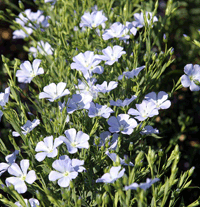Seeds Focus: Winter linseed offers alternative break crop

Winter linseed might make an alternative break crop for growers this autumn, looking to switch away from oilseed rape.
Bryce Rham, an independent agronomist from Shropshire, is exploring the possibility of recommending winter linseed to some customers with concerns about controlling disease and vermin.
“I’m looking at winter linseed as an alternative after seeing some farms and fields where we cannot grow rape or beans due to location, weed pressure and the threat of pigeons.”
Some growers have struggled to control broadleaved weeds like charlock, cleavers and runch, he says.
In addition, growers are reluctant to spend money on whirligigs and bangers to keep pigeons off because they are an easy target for thieves.
Andrew Probert, director of Premium Crops, who produce winter linseed variety WintaLin, says it is a break crop which offers a good alternative to winter beans and winter oilseed rape.
“Anyone can grow WintaLin, but we have especially targeted growers on heavy land on a continuous cropping rotation of wheat, rape who are having issues with the close rotation,” he explains.
“WintaLin is a useful alternative for the rape rotation and for those problem fields where people are struggling to control old-fashioned weeds like charlock, runch and cranesbill.”
Pre-emergence herbicides, such as Defy (prosulfocarb), can be used, along with a range of post-emergence herbicides, including Crawler (carbetamide), Butisan (metazachlor), many sulfonylureas, and any of the fops and dims.
Compared with growing winter rape, he estimates about half the amount of nitrogen is required, offering the grower a significant saving.
“Profitability on winter linseed is not going to be as good as a 4-5t/ha rape crop,” notes Mr Probert.
“But it is going to be much better than a 3-3.5t/ha crop.”
He also reckons winter linseed is a much cleaner and profitable crop to grow than winter beans.
“Winter beans were traditionally a ‘cheap’ crop to grow, but it has become more expensive due to the withdrawal of several key herbicides,” he explains.
“Unlike spring beans, you are less likely to get the export premium with winter beans so you risk being in the lower priced feed market.”
However, PGRO technical director Anthony Biddle says Wizard, the market leader in winter beans varieties, is a well-stablished brand in Egypt and North Africa.
“Wizard, Sultan and Husky are all pale hilum types and if the quality is good you are still in with a chance for export,” he says.
Wizard holds well in excess of 90% of the market, but some growers are considering Sultan and Husky, for this autumn, he adds.
For growing all varieties of winter beans, getting the right plant population is the most important aspect.
“You really want to finish up with 18-20 plants/sq m in the spring.”
Dan Wherry of Wherry & Sons confirms Wizard is the variety most in demand this year.
“Wizard is a nice, shiny sample which has exporting potential as long as the bruchid and weevil levels are controlled,” he says.
“It has been a strong variety for a few years and we are finding it so good it’s difficult to knock it off its perch.”

